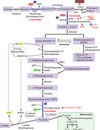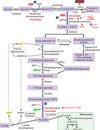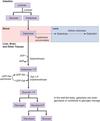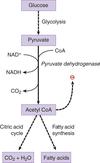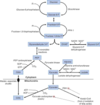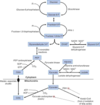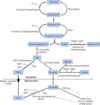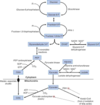Biochemistry 9: Carbohydrate Metabolism I Flashcards
GLUT 2
low-affinity transporter in hepatocytes and pancreatic cells
high Km - captures the excess glucose for storage after a meal
serves as the glucose sensor for insulin release in B-islet cells
insulin-dependent
Km for GLUT 2
15 mM
this means that the liver will pick up excess glucose after a meal and store it
GLUT 4
glucose transporter located in adipose tissue and muscle
responds to the glucose concentration in peripheral blood
insulin-dependent transport (increased insulin increases the number of transporters
how does insulin affect GLUT4?
stimulates the movement of additional GLUT 4 transporters to the membrane
Km for GLUT 4
5 mM (close to normal blood glucose level)
GLUT 4 is saturated when blood glucose levels are just a bit higher than normal
how does the liver utilize excess glucose?
uses glycolysis - excess glucose is converted to fatty acids for storage
how do the beta-islet cells in the pancrease know when to release insulin?
GLUT2 begins to transport glucose into the cell
glucokinase is induced by insulin; phosphorylates glucose -> G6P
what is the first step in Glucose Metabolism?
transport across the membrane (facilitated diffusion/active transport) & phosphorylation by kinase enzymes inside the cell to prevent glucose from leaving via the transporter
glucose —> glucose 6-phosphate

Hexokinase
widely distributed enzyme in tissues
glucose –> glucose 6-phosphate
Low Km (reaches vmax at low [glucose])
inhibited by G6P

Glucokinase
only in liver cells and pancreatic B-islet cells
glucose —> glucose 6-phosphate
induced by insulin in the liver (acts as a glucose sensor)
High Km (acts proportionally to [glucose])

Phosphofructokinase-1
rate-limiting enzyme and main control point in glycolysis
fructose 6-phosphate –> fructose 1,6 biphosphate
inhibited by ATP, citrate, and glucagon (indirectly)
(glycolysis shouldn’t be on if we have enough energy)
activated by AMP and insulin (indirectly)
(glycolysis should be on if we need energy)
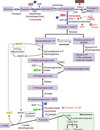
Phosphofructokinase-2
directly activated by insulin
converts a little fructose 6-phosphate —> fructose 2,6-bisphosphate (which activates PFK-1)
directly inhibited by glucagon, lowering F2,6-BP, inhibiting PFK-1
found mostly in the liver
can override the PFK-1 inhibition caused by ATP so that glycolysis can continue

Glyceraldehyde 3-phosphate dehydrogenase
catalyzes an oxidation and addition of Pi to substrate
glyceraldehyde 3-phosphate —>1,3-bisphosphoglycerate (high-energy intermediate)
reduction of NAD+ —> NADH

what is the difference between substrate-level and oxidative phosphorylation?
substrate level: ADP is directly phosphorylated to ATP using a high energy intermediate
oxidative: dependent on O2; ATP made from electron transport and chemiosmosis
3-Phosphoglycerate kinase
moves high energy Pi from 1,3-biphosphoglycerate (G3P dehydrogenase) to ADP –> ATP and 3-phosphoglycerate
3-phosphoglycerate –> 1,3 bisphosphoglycerate

Pyruvate Kinase
activated by fructose 1,6-bisphosphate from the PFK-1 reaction
an example of feed-forward activation
phosphoenolpyruvate (PEP) + ADP —> pyruvate + ATP

Lactate Dehydrogenase
key fermentation enzyme in mammalian cells when O2 or mitochondria are absent
oxidizes NADH to NAD+ (replenishing for G3P dehydrogenase)
reduces pyruvate to lactate
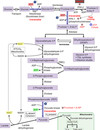
Dihydroxyacetone phosphate (DHAP)
glycolysis intermediate
used in hepatic and adipose tissue for triacylglycerol synthesis
formed from fructose 1,6-bisphosphate
can be isomerized to glycerol 3-phosphate <—> glycerol (backbone of triacyglycerols)
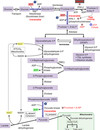
1,3-bisphosphate and phosphoenolpyruvate
high-energy intermediates used to generate ATP by substrate-level phosphorylation
only means of gaining ATP in anaerobic respiration

which enzymes in glycolysis are irreversible?
Hexokinase/Glucokinase, PFK-1, and Pyruvate kinase
How Glycolysis Pushes Forward the Process: Kinases
